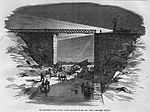Clappison's Corners, Ontario
AC with 0 elementsNeighbourhoods in Hamilton, OntarioOntario geography stubs
Clappison's Corners is a community located in the city of Hamilton, Ontario, Canada. In East and West Flamborough Ts., Reg. Mun. of Hamilton- Wentworth and Hwys 5 & 6, 7 km. NW of Hamilton. The community, also known as Clappisons Corners, Clappisons and Clappison was named after a family that settled at the junction of the two roadways. 17 Main N, Waterdown, Ontario
Excerpt from the Wikipedia article Clappison's Corners, Ontario (License: CC BY-SA 3.0, Authors).Clappison's Corners, Ontario
Dundas Street East, Hamilton
Geographical coordinates (GPS) Address Nearby Places Show on map
Geographical coordinates (GPS)
| Latitude | Longitude |
|---|---|
| N 43.313 ° | E -79.917 ° |
Address
Dundas Street East 6
L8B 0Y2 Hamilton
Ontario, Canada
Open on Google Maps






